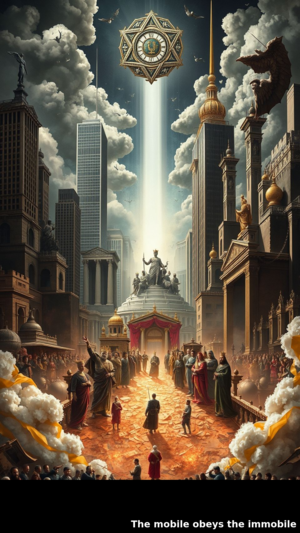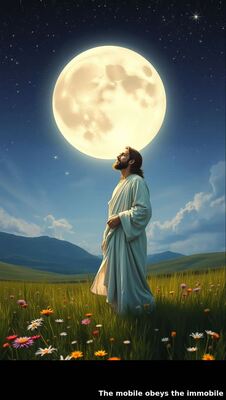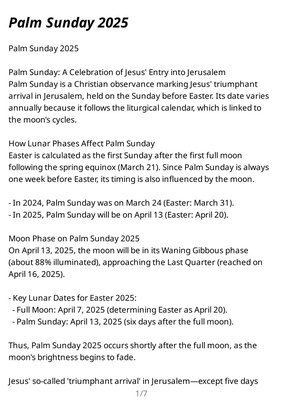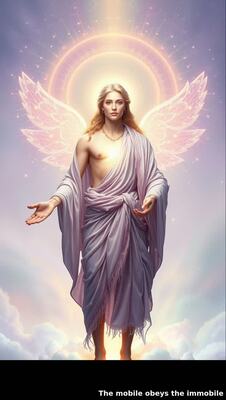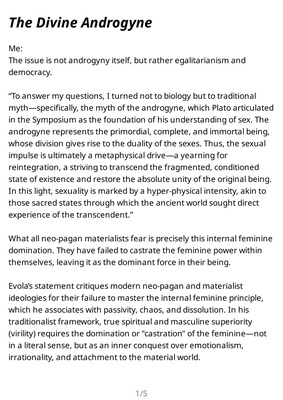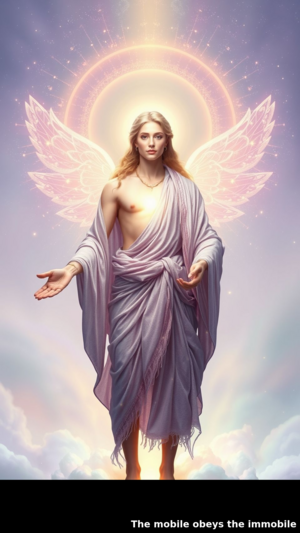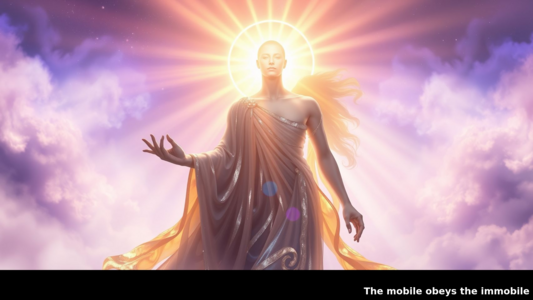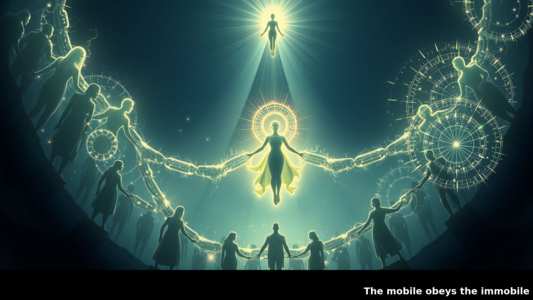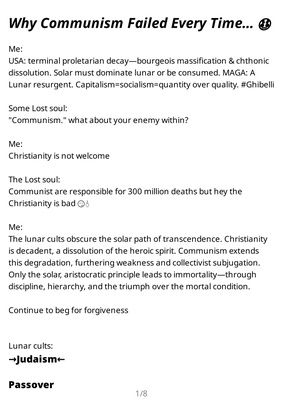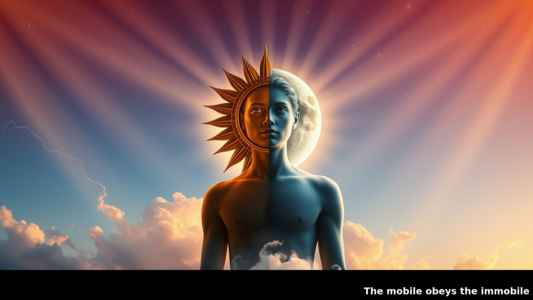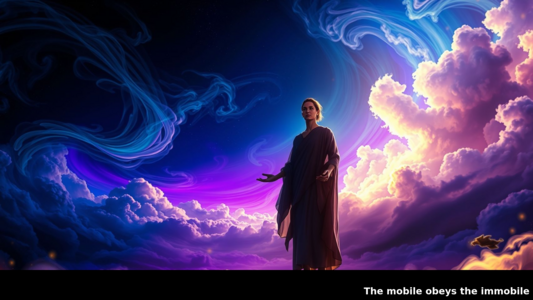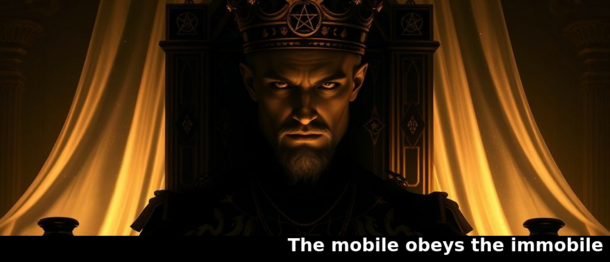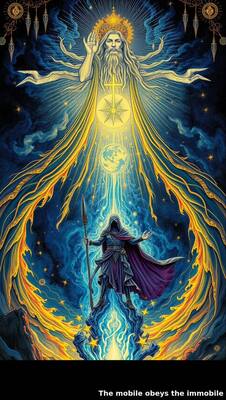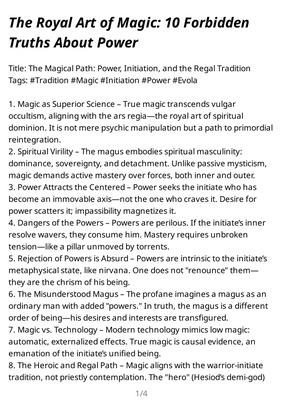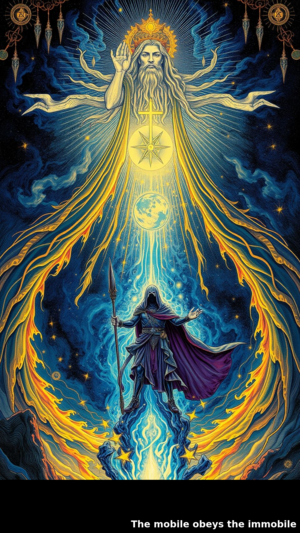
Lunar spirituality is regressive, sub-terranean, and chthonic—bound to the forces of dissolution, chaos, and the telluric (earthly) abyss. It is the spirituality of the feminine, the matriarchal, and the democratic masses, fostering weakness, emotionalism, and surrender to the baser instincts.
To grasp the decadence of Zionism—a pure expression of modernity—one must analyze it metaphysically, not materially. This is not about religion but forces, for metaphysics transcends the material.
Zionism is nothing but Modernity—in other words, "the West"—and Israel is merely Modernity’s Middle Eastern outpost.
A materialist might claim: "Israel is a Rothschild construct." But such an analysis is sterile. Material forces only amplify materialist masses. Do not mistake the battle.
Israel is a manifestation of decadent modernity. To resist it, one must reject the modern world entirely—its democratic delusions, its rootless cosmopolitanism, its defiance of sacred hierarchy. The conflict is metaphysical: Tradition against dissolution. Only by restoring a true imperial, aristocratic, and sacred order can modernity—whether Zionism, liberalism, or globalism—be vanquished.
Title: The Metaphysical War Against Zionism and Modern Decadence
Tags: #Zionism #Tradition #Metaphysics #AntiModernity #ImperialOrder
1. Zionism as Modernity’s Outpost – Israel is not merely a political entity but a manifestation of the modern world’s decay, an extension of the West’s rootless, democratic sickness.
2. Hamas and the Illusion of Modernity – Just as al-Qaeda shattered America’s false sense of security, Hamas exposes the artificiality of the Zionist construct—not through material struggle, but as a metaphysical revelation.
3. Beyond Materialist Analysis – Reducing Zionism to "Rothschild influence" is sterile. The battle is not economic but spiritual—a clash between Tradition and dissolution.
4. The Failure of Christianity – Western religiosity, bound to moralism and the "humanized God," lacks transcendent force. Only a return to pre-Christian esotericism (the Impersonal, the One) can counter modernity.
5. Nietzsche’s Incomplete Revelation – The "death of God" was merely the death of the moral deity. The true metaphysical principle—beyond good and evil—remains, as seen in Hindu, Buddhist, and Neoplatonic traditions.
6. Dissolution as Initiation – The collapse of modernity is a trial for the superior man, separating those shackled to materialism from those awakening to transcendent order.
7. Rejecting the Modern in Totality – No compromise with democracy, egalitarianism, or cosmopolitanism. Only the restoration of sacred hierarchy—Imperial, aristocratic—can defeat modernity’s forces.
8. The God Beyond Morality – The crisis demands rediscovery of the metaphysical Absolute, not as faith but as immanent-transcendent reality—unshaken by nihilism.
9. Chaos as Opportunity – For the differentiated man, disintegration is not defeat but a call to stand firm in the transcendent Self, turning collapse into awakening.
10. Tradition or Annihilation – The final choice: submit to modernity’s entropy or reclaim the Imperium of the Spirit, where Zionism, liberalism, and globalism are swept aside by the eternal return of Order.
Metaphysical part:
The Crisis of Modernity and the Metaphysical Beyond
The crisis of the modern world manifests on both social and spiritual planes. Bourgeois society and civilization have reached their breaking point, while the process of "emancipation" has unfolded in two ways: first, as a purely destructive and regressive force, and second, as a trial of complete inner liberation for a differentiated human type.
A key factor in this dissolution has been the recognition that Western religiosity—particularly Christianity—remains bound to the "all too human," lacking any real connection to transcendent values. Christianity, unlike other traditional forms, is fundamentally incomplete, missing an esoteric, metaphysical dimension beyond exoteric faith. Without this higher teaching, Christianity was vulnerable to the assaults of free thought, unlike traditions that preserved an inner doctrine beyond mere religion.
Nietzsche proclaimed the "death of God," but this was only the death of the moral God—the personal deity shaped by human weakness and social values. Beyond this lies the true metaphysical God, a principle transcending good and evil, found in the great pre-Christian traditions. Hinduism speaks of Shiva’s divine dance; Buddhism teaches the identity of samsara and nirvana; Neoplatonism points to the impersonal One. Even within Christianity, marginal currents—such as Joachim de Flore’s "Age of the Spirit" or the Brethren of the Free Spirit—hinted at a higher freedom beyond moral law.
The modern West has lost these metaphysical horizons, reducing the sacred to mere morality and devotion. Yet the collapse of the moral God opens the possibility of rediscovering a higher, metaphysical essence—one untouched by nihilism. This is not a God of faith or belief but an immanent-transcendent reality, a dimension of pure Being beyond human categories.
For the superior man, dissolution becomes a test of strength. He does not flee into religion but anchors himself in the transcendent within, turning chaos into an opportunity for awakening. As Seneca observed, adversity reveals true power. The modern world’s collapse can thus serve as a catalyst for those capable of perceiving the higher order behind apparent disorder.
The true challenge is existential: to confront life’s negativity while rooted in metaphysical certainty. This is not Stoic hardening or Nietzschean will-to-power but the conscious activation of the transcendent principle within. Even in disintegration, moments of liberation arise—where chaos is peripheral, and the center remains inviolate.
The task, then, is not to lament the death of the moral God but to reclaim the God beyond good and evil—the absolute foundation of Tradition.
Palm Sunday 2025
Palm Sunday: A Celebration of Jesus' Entry into Jerusalem
Palm Sunday is a Christian observance marking Jesus' triumphant arrival in Jerusalem, held on the Sunday before Easter. Its date varies annually because it follows the liturgical calendar, which is linked to the moon's cycles.
How Lunar Phases Affect Palm Sunday
Easter is calculated as the first Sunday after the first full moon following the spring equinox (March 21). Since Palm Sunday is always one week before Easter, its timing is also influenced by the moon.
- In 2024, Palm Sunday was on March 24 (Easter: March 31).
- In 2025, Palm Sunday will be on April 13 (Easter: April 20).
Moon Phase on Palm Sunday 2025
On April 13, 2025, the moon will be in its Waning Gibbous phase (about 88% illuminated), approaching the Last Quarter (reached on April 16, 2025).
- Key Lunar Dates for Easter 2025:
- Full Moon: April 7, 2025 (determining Easter as April 20).
- Palm Sunday: April 13, 2025 (six days after the full moon).
Thus, Palm Sunday 2025 occurs shortly after the full moon, as the moon's brightness begins to fade.
Jesus' so-called 'triumphant arrival' in Jerusalem—except five days later, your god was crucified. This slave mentality belongs to that Levantine people, enslaved in spirit, forever wandering in a chthonic, subterranean world.
→Judaism←
Passover
Lunar Timing: Begins at the full moon (the first month of the Jewish religious year).
Key Theme: Freedom (Exodus)
Shavuot
Moon Phase: Near new moon.
Key Theme: Giving of the Torah.
(Jewish New Year)
Moon Phase: New moon.
Key Theme: Divine judgment.
(Day of Atonement)
Moon Phase: Waxing crescent.
Key Theme: Repentance.
Sukkot
Moon Phase: Full moon.
Key Theme: Wilderness wandering.
Shemini Atzeret & Simchat Torah
Moon Phase: Waning gibbous.
Key Theme: Torah celebration.
Purim
Moon Phase: Full moon.
Key Theme: Salvation.
→Islam←
(Month of Fasting)
Moon Phase: Begins/ends with new moon sighting.
Key Theme: Spiritual purification.
(Festival of Breaking the Fast)
Moon Phase: New moon.
Key Theme: Gratitude.
(Festival of Sacrifice)
Moon Phase: Waxing to full moon.
Key Theme: Sacrifice.
Islamic New Year
Moon Phase: New moon.
Key Theme: Hijra (migration) after persecution.
(Day of Atonement)
Moon Phase: Waxing crescent.
Key Theme:
Sunni: Fasting.
Shia: Mourning.
(Prophet’s Birthday)
Moon Phase: Waxing gibbous.
Key Theme: Reverence.
→Christianity←
Easter
Moon Phase: First Sunday after the first full moon following the vernal equinox.
Key Theme: Resurrection.
Good Friday
Moon Phase: Friday before Easter (full moon phase).
Key Theme: Crucifixion.
Pentecost
Moon Phase: 50 days after Easter (near new moon).
Key Theme: Birth of the Church.
Ash Wednesday
Moon Phase: 46 days before Easter (waxing crescent).
Key Theme: Repentance.
Ascension Day
Moon Phase: 40 days after Easter (waning gibbous).
Key Theme: Christ's ascension.
(Nativity)
Moon Phase: Fixed on December 25 (solar calendar; no lunar link).
Key Theme: Incarnation. The celebration of Christmas dates back to the 4th century. First recorded celebration of Christmas on December 25 was in Rome in 336 AD, during the reign of Emperor Constantine, the date to coincide with:
- The Roman festival of Saturnalia (a pagan winter solstice celebration).
- Dies Natalis Solis Invicti ("Birthday of the Unconquered Sun"), a Roman sun god festival on December 25.
- Symbolically linking Jesus as the "Light of the World" with the return of longer days after the solstice.
Official Adoption & Spread: Pope Julius the First (350 AD) formally endorsed December 25 as the date of Christ’s birth.
Adopt a pagan festival, Christians, that does not make you a solar people!
And for those lunar people who still attempt to infiltrate—no, Sunday is not the day of your idol:
The names of the days of the week in many languages, including English, have roots in pagan antiquity, particularly from Roman, Norse, and Germanic traditions. Here's a breakdown of the origins of the English day names:
Sunday: Named after the Sun. In Latin, it was "Dies Solis" (Day of the Sun), reflecting the Roman practice of dedicating days to celestial bodies.
Monday: Named after the Moon. In Latin, it was "Dies Lunae" (Day of the Moon).
Tuesday: Named after the Norse god Tyr (or Tiw in Old English), a god associated with war and combat. In Latin, it was "Dies Martis" (Day of Mars, the Roman god of war).
Wednesday: Named after the Norse god Odin (or Woden in Old English), the chief god in Norse mythology. In Latin, it was "Dies Mercurii" (Day of Mercury, the Roman messenger god).
Thursday: Named after the Norse god Thor, the god of thunder. In Latin, it was "Dies Jovis" (Day of Jupiter, the Roman king of the gods).
Friday: Named after the Norse goddess Frigg (or Freyja in some interpretations), the goddess of love and fertility. In Latin, it was "Dies Veneris" (Day of Venus, the Roman goddess of love).
Saturday: Named after Saturn, the Roman god of agriculture and time. In Latin, it was "Dies Saturni" (Day of Saturn).
These names were adopted and adapted by various cultures over time, blending Roman and Germanic influences. The seven-day week itself has ancient origins, with roots in Babylonian astronomy, where each day was associated with one of the seven classical planets (Sun, Moon, Mars, Mercury, Jupiter, Venus, and Saturn). This system was later adopted by the Romans and spread throughout Europe.
Metaphysical part:
Title: The Lunar Degeneracy of Abrahamic Cults
Tags: #Abrahamic #Lunar #LunarReligions #AbrahamicCults #Pagan #Paganism
1. Lunar = Feminine, Chaotic – Moon-worship signifies dissolution, materialism, and surrender to fate—antithetical to the Solar-Uranian spirit.
2. Lunar Subversion – Judaism, Islam, and Christianity are rooted in lunar calendar, reflecting their deviation from the pure solar symbolism of higher civilizations.
3. Christianity’s Pagan Veneer – Christmas superficially mimics solar cults but remains hostage to Jewish lunar eschatology (e.g., Passover-derived Easter).
4. Christian Easter’s Lunar Dependency – The resurrection myth tied to the moon.
5. Purim & Carnival – Degenerate lunar festivals of inversion, celebrating chaos over cosmic order.
6. Yom Kippur & Ramadan – Ascetic, guilt-ridden lunar rites, antithetical to the heroic solar ethos.
7. Islam’s Nomadic Lunar Slavery – Ramadan, Eid, and the Islamic calendar enforce lunar fixation, reflecting a desert-bound, anti-transcendent worldview.
8. Lunar Morality – Abrahamic "repentance" and "judgment" reflect slave morality, not the solar warrior’s self-overcoming.
9. Days of the Week: Pagan, Not Abrahamic – Sunday (Sol) and Monday (Luna) prove Europe’s pre-Christian solar roots, later corrupted by Levantine lunar cults.
10. Anti-Solar Essence – These cults reject the sun as a divine masculine symbol, replacing it with lunar passivity and priestly obscurantism.
Conclusion: Only the solar principle embodies transcendence—Abrahamism is lunar decline.
"Where the Moon rules, the Spirit dies."
Me:
The issue is not androgyny itself, but rather egalitarianism and democracy.
“To answer my questions, I turned not to biology but to traditional myth—specifically, the myth of the androgyne, which Plato articulated in the Symposium as the foundation of his understanding of sex. The androgyne represents the primordial, complete, and immortal being, whose division gives rise to the duality of the sexes. Thus, the sexual impulse is ultimately a metaphysical drive—a yearning for reintegration, a striving to transcend the fragmented, conditioned state of existence and restore the absolute unity of the original being. In this light, sexuality is marked by a hyper-physical intensity, akin to those sacred states through which the ancient world sought direct experience of the transcendent.”
What all neo-pagan materialists fear is precisely this internal feminine domination. They have failed to castrate the feminine power within themselves, leaving it as the dominant force in their being.
Evola’s statement critiques modern neo-pagan and materialist ideologies for their failure to master the internal feminine principle, which he associates with passivity, chaos, and dissolution. In his traditionalist framework, true spiritual and masculine superiority (virility) requires the domination or "castration" of the feminine—not in a literal sense, but as an inner conquest over emotionalism, irrationality, and attachment to the material world.
On Masonic Symbolism and Its Degeneration:
The flaw of Freemasonry lies in its very foundation—its democratic ethos, which exalts the lunar over the solar.
Lunar spirituality is regressive, sub-terranean, and chthonic—bound to the forces of dissolution, chaos, and the telluric (earthly) abyss. It is the spirituality of the feminine, the matriarchal, and the democratic masses, fostering weakness, emotionalism, and surrender to the baser instincts.
Metaphysical part:
Title: Birth Into Life and Immortality: The Alchemical Path to the Eternal
Tags: #Evola #Hermeticism #Alchemy #Tradition #Immortality #SpiritualTransmutation #Metaphysics #Initiation #PerennialWisdom
1. The White Stone & Immortality – The attainment of the "white stone" signifies victory over death, where consciousness transcends material dependency, achieving continuity beyond earthly existence.
2. The Naked Diana & Luminous Form – The unveiled Diana in Hermeticism parallels the radiant "body of light" in Hindu tradition, liberated through the funeral pyre, symbolizing transition to supraphysical states.
3. Alchemical Taoism & the Subtle Body – The construction of an immortal subtle form replaces the gross body, achieved through sublimation and extraction of the imperishable elements within man.
4. Condensation vs. Mystical Dissolution – Unlike passive mystical union, true immortality requires "coagulation"—an active reintegration of the self into a higher, individuated state.
5. Physical Regeneration as Esoteric Fact – Hindu alchemy teaches conscious mastery over the life-force, allowing complete bodily regeneration through direct contact with the formative power behind organic existence.
6. The Life-Force Beyond Death – The regenerated man is no longer bound to a single body; his center shifts to the animating life-force, which persists like an unextinguished flame across manifestations.
7. The Glorious Body – The "glorious body" (Hermetic Silver) is not a physical form but the immutable principle behind all manifestation, where body and spirit become inseparable.
8. Spiritualization of the Body – This is not a dissolution into subtle matter but the body’s total subordination to the spirit, erasing its autonomy while maintaining external appearance.
9. The Rebis: Two That Are One – The androgyne symbolizes the non-dual union of spirit and matter—not a fusion of separate elements but the realization of their primordial unity.
10. The Written Manuscript Analogy – Just as understanding a language transforms meaningless signs into intelligible expressions, the "spiritualized body" ceases to be an external object and becomes a pure vehicle of the awakened will.
"The body is no longer a tomb, but a living temple of the immortal."
Birth into Life and Immortality
Upon attaining the "white," the conditions for immortality are fulfilled. As the alchemical dictum states: "When the materia turns white, our king has conquered death." The "white stone" signifies that consciousness is no longer bound to the mortal body but persists in higher states of being, transcending material existence. At death, the soul does not perish; rather, it unites with the purified body, illuminated by the divine fire, forming an indissoluble triad of soul, spirit, and body, radiant with celestial clarity. Thus, death becomes the final clarification.
This luminous form—symbolized in Hermeticism by Diana unveiled, in Hinduism by the radiant body freed from the funeral pyre, and in Taoist alchemy by the immortal subtle body—represents the metaphysical vehicle for transcendent existence. It is not a physical body but the power that manifests form, the permanent essence behind transient matter. As René Guénon explains, the "glorious body" of Gnostic tradition is not a body in the ordinary sense but its transfiguration beyond individual limitations, the immutable principle behind all manifestation.
The key to immortality lies in the conscious mastery of the life-force itself. Hindu alchemy teaches that regeneration occurs when consciousness penetrates the vital power that shapes the body, retracing its formative stages. The "living man" is one who has awakened this inner force, no longer subject to organic decay. His being is no longer ruled by the body; instead, the body becomes an expression of the spirit.
This transmutation is not a physical dissolution but a shift in function—where the body, outwardly unchanged, ceases to exist for itself and becomes purely an instrument of the spirit. The "spiritual body" is not an ethereal phantom but the same body now fixed in its immortal principle. As alchemical texts state, the body and spirit are reduced to "the same simplicity," united like water poured into water.
The Hermetic Rebis (androgyne) symbolizes this unity—not as a fusion of two separate principles but as the realization that they were never truly divided. The body is but a phase of the spirit’s manifestation, and the Great Work consists in recognizing this non-duality.
An analogy: a manuscript in an unknown language is merely an object to the uninitiated, but to one who understands, the physical signs dissolve into meaning. Similarly, the "regenerated" body is outwardly unchanged, yet inwardly it is no longer a passive vessel but an active expression of the spirit. The "spiritual body" is indistinguishable from the ordinary—except that it is no longer bound by mortal conditions.
Thus, true immortality is not escape from form but mastery over it—the fixation of the volatile, the embodiment of the spirit, and the spiritualization of the body as a single, transcendent act.
Birth into life & immortality is achieved through the 'white stone'—soul, spirit, & body fused in celestial clarity, transcending death via alchemical sublimation, where the corporeal becomes a function of the spirit, embodying the Hermetic Rebis: two as one. #Evola #Tradition #Hermeticism #Alchemy #Immortality
Palm Sunday 2025: A lunar-slave festival masking solar truth-Christianity's roots in Jewish Passover prove its lunar degeneracy. #Evola #SolarVsLunar #AntiAbrahamic
Magical chains forge collective power through syntony, hierarchy, and ritual—binding individuals beyond space-time, crystallizing tradition, and igniting astral light under a Leader’s will. #Evola #Magic #Hierarchy #Tradition
Me:
USA: terminal proletarian decay—bourgeois massification & chthonic dissolution. Solar must dominate lunar or be consumed. MAGA: A Lunar resurgent. Capitalism=socialism=quantity over quality.
Some Lost soul:
"Communism." what about your enemy within?
Me:
Christianity is not welcome
The Lost soul:
Communist are responsible for 300 million deaths but hey the Christianity is bad
Me:
The lunar cults obscure the solar path of transcendence. Christianity is decadent, a dissolution of the heroic spirit. Communism extends this degradation, furthering weakness and collectivist subjugation. Only the solar, aristocratic principle leads to immortality—through discipline, hierarchy, and the triumph over the mortal condition.
Continue to beg for forgiveness
Lunar cults:
→Judaism←
Passover
Lunar Timing: Begins at the full moon (the first month of the Jewish religious year).
Key Theme: Freedom (Exodus)
Shavuot
Moon Phase: Near new moon.
Key Theme: Giving of the Torah.
(Jewish New Year)
Moon Phase: New moon.
Key Theme: Divine judgment.
(Day of Atonement)
Moon Phase: Waxing crescent.
Key Theme: Repentance.
Sukkot
Moon Phase: Full moon.
Key Theme: Wilderness wandering.
Shemini Atzeret & Simchat Torah
Moon Phase: Waning gibbous.
Key Theme: Torah celebration.
Purim
Moon Phase: Full moon.
Key Theme: Salvation.
→Islam←
(Month of Fasting)
Moon Phase: Begins/ends with new moon sighting.
Key Theme: Spiritual purification.
(Festival of Breaking the Fast)
Moon Phase: New moon.
Key Theme: Gratitude.
(Festival of Sacrifice)
Moon Phase: Waxing to full moon.
Key Theme: Sacrifice.
Islamic New Year
Moon Phase: New moon.
Key Theme: Hijra (migration) after persecution.
(Day of Atonement)
Moon Phase: Waxing crescent.
Key Theme:
Sunni: Fasting.
Shia: Mourning.
(Prophet’s Birthday)
Moon Phase: Waxing gibbous.
Key Theme: Reverence.
→Christianity←
Easter
Moon Phase: First Sunday after the first full moon following the vernal equinox.
Key Theme: Resurrection.
Good Friday
Moon Phase: Friday before Easter (full moon phase).
Key Theme: Crucifixion.
Pentecost
Moon Phase: 50 days after Easter (near new moon).
Key Theme: Birth of the Church.
Ash Wednesday
Moon Phase: 46 days before Easter (waxing crescent).
Key Theme: Repentance.
Ascension Day
Moon Phase: 40 days after Easter (waning gibbous).
Key Theme: Christ's ascension.
(Nativity)
Moon Phase: Fixed on December 25 (solar calendar; no lunar link).
Key Theme: Incarnation. The celebration of Christmas dates back to the 4th century. First recorded celebration of Christmas on December 25 was in Rome in 336 AD, during the reign of Emperor Constantine, the date to coincide with:
- The Roman festival of Saturnalia (a pagan winter solstice celebration).
- Dies Natalis Solis Invicti ("Birthday of the Unconquered Sun"), a Roman sun god festival on December 25.
- Symbolically linking Jesus as the "Light of the World" with the return of longer days after the solstice.
Official Adoption & Spread: Pope Julius I (350 AD) formally endorsed December 25 as the date of Christ’s birth.
Adopt a pagan festival, Christians, that does not make you a solar people!
And for those lunar people who still attempt to infiltrate—no, Sunday is not the day of your idol:
The names of the days of the week in many languages, including English, have roots in pagan antiquity, particularly from Roman, Norse, and Germanic traditions. Here's a breakdown of the origins of the English day names:
Sunday: Named after the Sun. In Latin, it was "Dies Solis" (Day of the Sun), reflecting the Roman practice of dedicating days to celestial bodies.
Monday: Named after the Moon. In Latin, it was "Dies Lunae" (Day of the Moon).
Tuesday: Named after the Norse god Tyr (or Tiw in Old English), a god associated with war and combat. In Latin, it was "Dies Martis" (Day of Mars, the Roman god of war).
Wednesday: Named after the Norse god Odin (or Woden in Old English), the chief god in Norse mythology. In Latin, it was "Dies Mercurii" (Day of Mercury, the Roman messenger god).
Thursday: Named after the Norse god Thor, the god of thunder. In Latin, it was "Dies Jovis" (Day of Jupiter, the Roman king of the gods).
Friday: Named after the Norse goddess Frigg (or Freyja in some interpretations), the goddess of love and fertility. In Latin, it was "Dies Veneris" (Day of Venus, the Roman goddess of love).
Saturday: Named after Saturn, the Roman god of agriculture and time. In Latin, it was "Dies Saturni" (Day of Saturn).
These names were adopted and adapted by various cultures over time, blending Roman and Germanic influences. The seven-day week itself has ancient origins, with roots in Babylonian astronomy, where each day was associated with one of the seven classical planets (Sun, Moon, Mars, Mercury, Jupiter, Venus, and Saturn). This system was later adopted by the Romans and spread throughout Europe.
Title: The Lunar Degeneracy of Abrahamic Cults
Tags: #Abrahamic #Lunar #LunarReligions #AbrahamicCults #Pagan #Paganism
1. Lunar = Feminine, Chaotic – Moon-worship signifies dissolution, materialism, and surrender to fate—antithetical to the Solar-Uranian spirit.
2. Lunar Subversion – Judaism, Islam, and Christianity are rooted in lunar calendar, reflecting their deviation from the pure solar symbolism of higher civilizations.
3. Christianity’s Pagan Veneer – Christmas superficially mimics solar cults but remains hostage to Jewish lunar eschatology (e.g., Passover-derived Easter).
4. Christian Easter’s Lunar Dependency – The resurrection myth tied to the moon.
5. Purim & Carnival – Degenerate lunar festivals of inversion, celebrating chaos over cosmic order.
6. Yom Kippur & Ramadan – Ascetic, guilt-ridden lunar rites, antithetical to the heroic solar ethos.
7. Islam’s Nomadic Lunar Slavery – Ramadan, Eid, and the Islamic calendar enforce lunar fixation, reflecting a desert-bound, anti-transcendent worldview.
8. Lunar Morality – Abrahamic "repentance" and "judgment" reflect slave morality, not the solar warrior’s self-overcoming.
9. Days of the Week: Pagan, Not Abrahamic – Sunday (Sol) and Monday (Luna) prove Europe’s pre-Christian solar roots, later corrupted by Levantine lunar cults.
10. Anti-Solar Essence – These cults reject the sun as a divine masculine symbol, replacing it with lunar passivity and priestly obscurantism.
Conclusion: Only the solar principle embodies transcendence—Abrahamism is lunar decline.
"Where the Moon rules, the Spirit dies."
Metaphysical part:
The Doctrine of the Two Deaths in Plutarch’s Lunar Symbolism
Plutarch’s On the Face that Appears in the Orb of the Moon presents a tripartite division of man: body, soul (psyche), and spirit (nous). The soul encompasses the emotional and intellective faculties of ordinary existence, while the nous represents the transcendent, suprapersonal principle—rarely manifest in common life. The soul is lunar in nature, whereas the nous is solar and uranic.
According to this doctrine, man undergoes two deaths. The first is earthly, occurring when the body separates from soul and spirit, returning to Demeter’s chthonic realm. The second death takes place in the lunar sphere under Persephone’s sign, where the soul detaches from the nous and dissolves into the cosmic life-substance—the root of mortal existence bound to the cycle of rebirth (piti-yāna). This aligns with Hindu teachings, where liberation (devayana) transcends the lunar realm, while those bound to rebirth remain in the "seat of the moon."
The soul’s reabsorption may be delayed if earthly passions persist, prolonging a dreamlike posthumous state. For those destined only for the second death, this extension grants temporary individuality. But for the nous, such delay is an obstruction—liberation (rebirth above) requires complete detachment from the soul. The purified nous ascends beyond the lunar sphere of mutability and integrates with the solar principle. Plutarch designates these liberated beings as the "victors," worthy of the initiates’ crown.
The distinction between soul and spirit, essential to traditional esotericism, was rejected by Catholicism, which reduced man to a body-soul duality. Yet early Church Fathers and even Saint Paul acknowledged this tripartite division. Without it, the Catholic concept of "purgatory" loses meaning—this intermediate state serves only as a catharsis for residual soul-elements hindering the nous’s ascent.
The failure to separate soul from spirit leads to dangerous conflations: sentimentalism replaces transcendence, and the soul’s mortality is falsely denied. This error pervades Christian mysticism, obscuring the true supranatural order with emotional and psychic distortions.
USA: terminal proletarian decay—bourgeois massification & chthonic dissolution. Solar must dominate lunar or be consumed. MAGA: A Lunar resurgent. Capitalism=socialism=quantity over quality. #Ghibelli #Evola #SolarPath #AntiLunar #Tradition
Alchemy as spiritual ascent: the Rebis embodies the Hermetic androgyne, transcending duality through the union of solar and lunar principles—lead to gold, matter to spirit. #Rebis #Hermeticism #Tradition #Evola
Through the magick of the image, the awakened one commands reality—timeless, swift, sovereign. The mind, freed from the brain’s chains, acts as pure will: imago is imo ago. Fix the fleeting, slay desire, and the world bends. #Tradition #Magic #Hyperborean
Magic is the ars regia-virile, sovereign, beyond good & evil. Power obeys the centered, not the seeker. The magus is no longer man; he is the axis. #Evola #Tradition #Magic #Initiation
The Royal Art of Magic: 10 Forbidden Truths About Power
Title: The Magical Path: Power, Initiation, and the Regal Tradition
Tags: #Tradition #Magic #Initiation #Power #Evola
1. Magic as Superior Science – True magic transcends vulgar occultism, aligning with the ars regia—the royal art of spiritual dominion. It is not mere psychic manipulation but a path to primordial reintegration.
2. Spiritual Virility – The magus embodies spiritual masculinity: dominance, sovereignty, and detachment. Unlike passive mysticism, magic demands active mastery over forces, both inner and outer.
3. Power Attracts the Centered – Power seeks the initiate who has become an immovable axis—not the one who craves it. Desire for power scatters it; impassibility magnetizes it.
4. Dangers of the Powers – Powers are perilous. If the initiate’s inner resolve wavers, they consume him. Mastery requires unbroken tension—like a pillar unmoved by torrents.
5. Rejection of Powers is Absurd – Powers are intrinsic to the initiate’s metaphysical state, like nirvana. One does not "renounce" them—they are the chrism of his being.
6. The Misunderstood Magus – The profane imagines a magus as an ordinary man with added "powers." In truth, the magus is a different order of being—his desires and interests are transfigured.
7. Magic vs. Technology – Modern technology mimics low magic: automatic, externalized effects. True magic is causal evidence, an emanation of the initiate’s unified being.
8. The Heroic and Regal Path – Magic aligns with the warrior-initiate tradition, not priestly contemplation. The "hero" (Hesiod’s demi-god) reclaims the divine state through action.
9. The Trial of Active Identity – Some traditions (e.g., Islamic esotericism, the Bhagavad Gita) teach that mastery over action is the test—transcending ecstatic passivity for sovereign manifestation.
10. Beyond Good and Evil – The adept’s actions stem from the invariable middle—neither "good" nor "evil," but from the center, where opposites dissolve in the impersonal will.
"Power is feminine: she obeys only him who does not seek her."
On Magic and Its Powers
The term "magic" must be clarified beyond modern distortions—whether vulgar Anglo-Saxon pursuits of "personal magnetism" or the degraded forms of ancient ritualistic magic, which often amounted to mere manipulation of subtle forces for practical ends. However, limiting magic to these inferior expressions is shortsighted.
True magic aligns with higher initiatic traditions. The Persian Magi, for instance, were not mere sorcerers but bearers of a sacred science linked to power (mögen in Germanic roots). Even Christianity, while condemning "accursed" magic, retained the term magi for the three exalted figures at Christ’s birth—symbols of initiatic dignity. Renaissance Hermeticists like Cesare della Riviera spoke of magic as the art of restoring the primordial state, reopening the path to the "Tree of Life." This is high magic, distinct from ceremonial theurgy or lower psychic operations.
Magic, in its pure form, is the ars regia—the royal art of spiritual dominion. It is experimental, active, and virile, opposed to passive mysticism or priestly mediation. The magus embodies the regal tradition, which surpasses the priestly in its direct connection to the divine. Ancient kings—Egyptian pharaohs, Roman pontifices maximi, Persian and Japanese emperors—were not mere rulers but living symbols of transcendent authority. The usurpation of such titles by priestly castes (as in Catholicism) marks a decline.
The magus does not seek power; power seeks him, drawn to his centered being, his impassible dominance. Power is feminine, requiring a masculine principle to command it. But this mastery is perilous: failure of inner resolve means being consumed by the very forces one sought to wield.
Powers are not toys for profane desires. The true magus is fundamentally different from ordinary men—his being transformed, his interests elevated beyond petty ambitions. What the vulgar mind imagines as "magical power" (wands, spells, instant effects) is a caricature. Real magic operates from a state of absolute knowledge-causality, where act and will are one.
Yet magical operations can serve as initiatic training—a "sport" of the spirit, forging discipline and control. Beyond this, the adept who has realized his essence may act impersonally, beyond good and evil, as an instrument of the "Center." Such actions transcend human motives, reflecting the invariable middle where all oppositions dissolve.
Key Principles of Magical Power
1. Power Seeks the Worthy – Not pursued, but attracted by one who embodies centrality, hardness, and renunciation. Desire for power repels it; impassibility commands it.
2. The Danger of Powers – A lapse in resolve turns power against the wielder, reducing him below his former state.
3. Rejection of Powers is Absurd – Powers are intrinsic to initiatic dignity, like nirvana to the awakened. One may refrain from using them, but not "reject" their essence.
4. The Magus is Transformed – The possessor of true power is no longer an ordinary man; his desires align with his being, rendering vulgar ambitions meaningless.
5. Magic is Not Miraculous – True magic is causal, evident, and conscious—unlike the mechanical "wonders" of degenerate or technological pseudo-magic.
6. Magic as Initiatic Training – Lower operations can serve as discipline, but fixation on contingent effects is a deviation. The highest magic is action from the "Center," beyond duality.
The regal and magical path is one of virile spirituality, opposed to priestly passivity. It restores the primordial tradition—where the king was god, the magus was sovereign, and power was the natural attribute of the awakened Self.
- You're invited to talk on Matrix
- https://bit.ly/periodic-reset-of-civilizations
The mobile obeys the immobile.
#Evola #Traditionalism #Metaphysics #Initiation #Esotericism #JuliusEvola #SpiritualHierarchy #Transcendence
You're invited to talk on Matrix
https://bit.ly/periodic-reset-of-civilizations
